Nowadays, smartphone or mobiles are the integral part of it.
We all use our mobiles and smartphones all day. Have you ever wondered what is inside your smartphone?
A mobile phone or a smartphone is an assembly of various components contained in a single unit making the device do multiple functions.
Here we give a complete in-depth about the components of a smartphone.
Now, there are plenty of companies making a smartphone or a mobile phone. So, there are regular updates of the softwares and the hardwares of our mobile phones.
The list of components of a smartphone are
Smartphone Display
Displays make the most prominent part of a mobile phone or smartphone. It an internal component of the mobile phone.
Display technologies in smartphones recently used are
1) Based on LCDs (IPS technology and its variations )
2) Based on LEDs (AMOLED or Super AMOLED and its variations)
You can read the complete article about the All this Displays. It is very well described in this article.

Battery
The mobile phones or smartphone are normally powered with the Lithium-ion technology which can be removable or non-removable.
In the Lithium powered batteries, the negative terminal is the Lithium which is responsible for the electrons in the battery and hence the charge. The Lithium on the negative terminal of the battery is stored in the layers of the Carbon Graphite. The Mobile phones or smartphones are rated with 3.7 volts.
The power rating of battery is normally given in mAh. mAh is milli-amp hour.
Example, 4000 mAh battery could power a device drawing 100 mA (milliamp) for 40 hours. A device drawing 200 mA would last only 20 hours.
System-on-a- Chip or SOC
System on a chip or SOC is the most important part of the mobile phone or smartphone. It not only contains the processor to complete the tasks, but also has graphics chips, the cellular radios, image processors, mobile RAM, audio/video decoders, LTE modems and so on. Some of the leading companies developing the SOCs are Qualcomm, MediaTek, Samsung, etc.
Memory Storage
The Smartphones and mobile devices requires a place to store the data or the programs to run the Operating System. So mobile devices come with the RAM and memory. Firstly the Smartphones, is installed with LPDDR3 or LPDDR4. Here LPDDR stands for Low Power Double Data Rate SDRAMs. Double Data Rate, in computing systems is that the transfer of data takes place both on rising edge and falling edge thus making the transfer twice faster than usual. The High-end smartphone or mobile phones uses LPDDR4X SDRAMs.
Now for the internal storage, the Smartphone or Mobile phones contains the flash memory which ranges from 32GB and can go upto 256GB, 512GBs too.

Cameras
Potentially all the smartphone users want their smartphone with the best cameras. Thus every company are working to update the cameras to give the best output to their users. All smartphones nowadays comes with rear-facing and front shooting cameras. Every smartphone has 3 components,
Lens,
Sensor, and
Image Processor
The light from the object passes through the lens to the sensor of the camera. A good Sensor of camera can give a good depth to the image than the marketed term MEGAPIXELS!
Sensors
Normally the Smartphones or the mobile phones comes with certain sensors.
They are
Proximity Sensor : To lock the screen automatically while you are on a call and has put your phone on the face, to avoid unnecessary touch to the screen.
Accelerometer : Detect the orientation of the device and its movements, as well as allow features like shaking the phone to change music.
Gyroscope: Works with the Accelerometer to detect the rotation of your phone, for features like tilting phone to play racing games or to watch a movie.
Digital Compass: Helps the phone to find the North direction, for map/navigation purposes.
Ambient Light Sensor: This sensor is automatically able to set the screen brightness based on the surrounding light, and helps conserve battery life.

